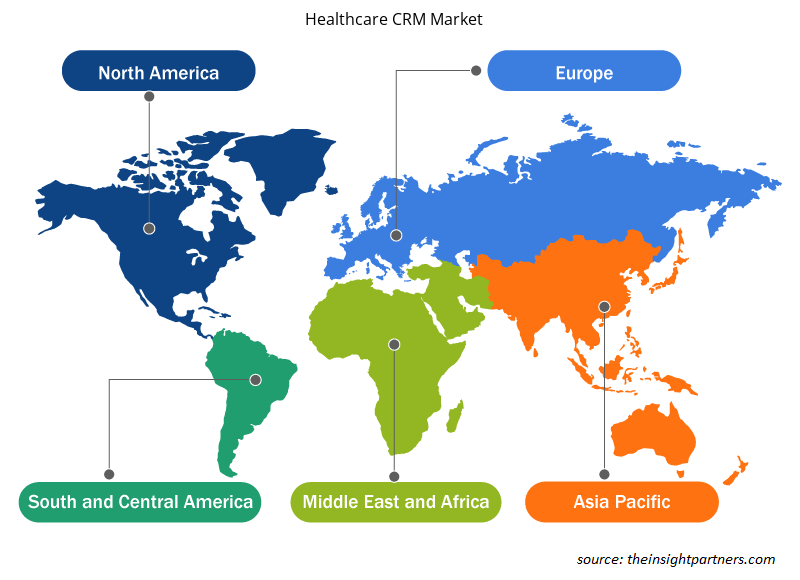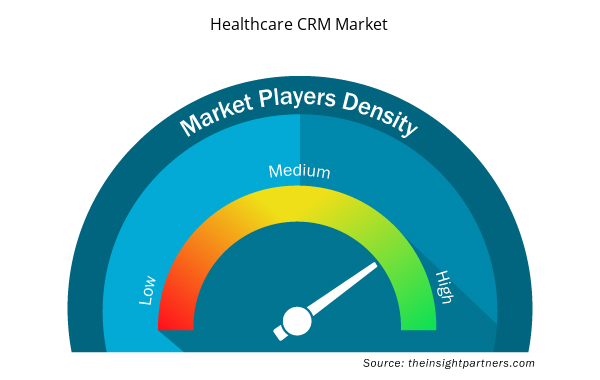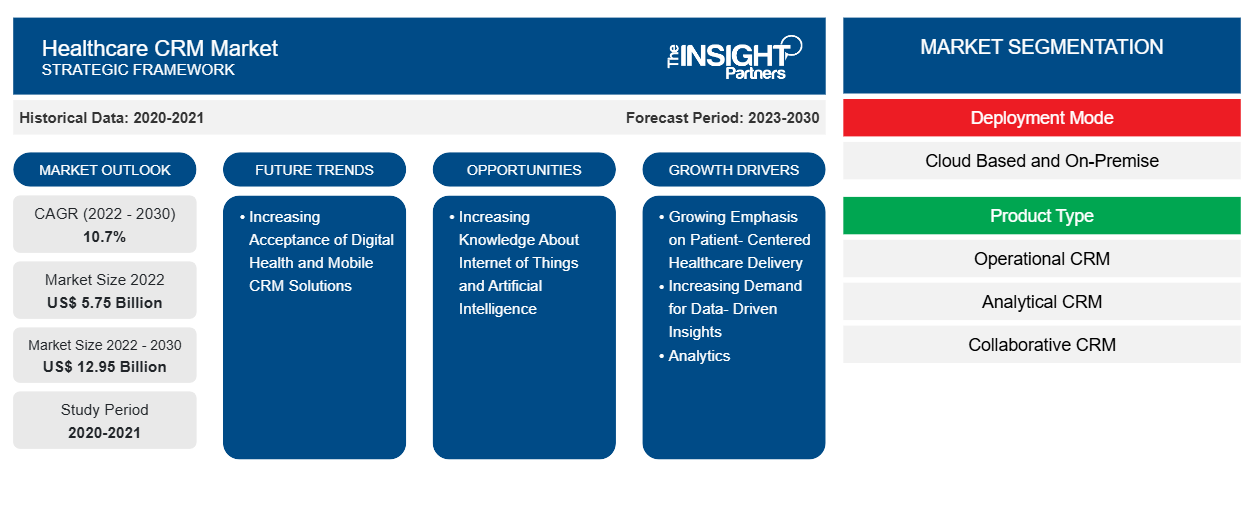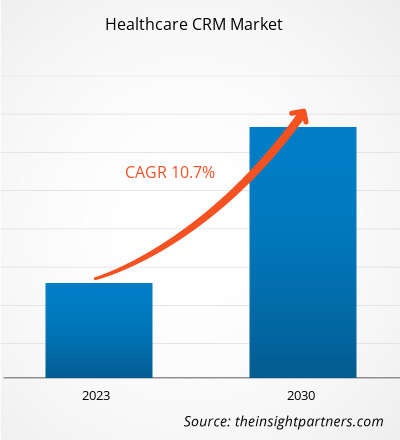[調査レポート] ヘルスケア CRM の市場価値は、2022 年の 57 億 5,095 万米ドルから 2030 年には 129 億 4,715 万米ドルに成長すると予測されており、2022 年から 2030 年にかけて CAGR 10.7% で成長する見込みです。
市場洞察とアナリストの見解:
ヘルスケア CRM は、医療サービス プロバイダーが患者情報を保存および管理し、サービスとエンゲージメントを改善し、患者獲得戦略を改善し、ヘルスケア セキュリティ標準に準拠しながらマーケティングと販売業務を自動化するのを支援する業界固有のシステムです。ヘルスケア CRM 市場の成長を牽引する主な要因には、患者中心のヘルスケア提供への重点の高まりと、データ主導の洞察、分析、および集団健康管理に対する需要の増加が含まれます。ただし、データ セキュリティの欠如と患者情報のプライバシーに関する懸念が、ヘルスケア CRM 市場の成長を妨げています。
成長の原動力と制約:
医療システムにおける患者中心のアプローチは、患者、その家族、医療従事者の間で協力関係を築き、患者のニーズ、好み、要求に応じて決定を調整することができます。また、患者が特定の決定を下し、治療に参加できるように、患者に特別な教育とサポートを提供することも含まれます。
すべての関係者 (医療提供者、患者、その他) との関わりが深まると、全体的な経費が削減されます。さらに、患者の健康、幸福、医療の選択肢に関する知識と理解が向上すると、ケアが強化され、病気のレベルが軽減されます。この知識の向上により、退院後のケア、病院への通院、再入院の減少、二次診察が容易になります。医療提供者は、意思決定において患者と関わり協力することで、患者の健康に関するより適切な決定を下すことができます。また、医療の質とコストの両方に基づいて患者獲得を競う病院が増えるため、競争上の優位性も高まります。患者の生活の質が向上すると、医師と患者の満足度が向上します。
要件に合わせてレポートをカスタマイズする
このレポートの一部、国レベルの分析、Excelデータパックなど、あらゆるレポートを無料でカスタマイズできます。また、スタートアップや大学向けのお得なオファーや割引もご利用いただけます。
- このレポートの主要な市場動向を入手してください。この無料サンプルには、市場動向から見積もりや予測に至るまでのデータ分析が含まれます。
技術革新とソフトウェア開発は、医療業界の革命に不可欠です。これらの技術開発は、医療プロセス、コミュニケーション、ワークフローを大幅に強化し、簡素化する医療および管理サービスをサポートします。患者中心の医療は患者の満足度を高め、医療提供者と医療現場に利益をもたらします。したがって、医療提供者による患者中心のアプローチの採用の増加が、医療 CRM 市場の成長を促進しています。
しかし、CRM ポータルに保存されている機密性の高い健康データの保護は、医療提供者とケアを受ける人々の間で大きな懸念事項です。CRM を操作するエンド ユーザーが個人データを第三者に販売する可能性があるため、患者は生物学的データを含む可能性のある個人データのプライバシーを心配しています。さらに、これらのデバイスが患者の医療費請求記録に接続されている場合、リスクはさらに金融データ漏洩を伴う可能性があります。HIPAA Journal によると、2009 年から 2022 年の間に、500 件を超える記録の医療データ漏洩が 5,150 件、HHS の公民権局に報告されています。これらの漏洩により、382,262,109 件の医療記録が露出または不当に開示されました。これは米国の人口の 1.2 倍以上に相当します。2022 年には、500 件以上の医療記録のデータ漏洩が 1 日平均 1.94 件報告されました。テクノロジー企業は自社製品のセキュリティ強化にますます多額の投資を行っていますが、消費者がヘルスケア関連の活動にソフトウェアに完全に依存するようになるには、まだ時間がかかると思われます。そのため、データ セキュリティとプライバシーに関する問題が CRM ソフトウェアの採用を制限し、市場の成長を妨げています。
トレンド:
ヘルスケア分野でデジタルヘルスとモバイル顧客関係管理 (CRM) ソリューションを受け入れる傾向が高まっており、ヘルスケア CRM の状況が再形成され、患者のエンゲージメント、仮想ヘルスケアの提供、モバイル ケアの調整を効率化する革新的なプラットフォームの需要が高まっています。デジタルヘルスの受け入れが進むことで、ヘルスケア業界はデジタル チャネル、モバイル テクノロジー、強化された患者エクスペリエンスを活用して、ケアの提供と患者満足度を最適化できるようになります。
医療インフラ内でのデジタルヘルスの受け入れは、ケア調整ツール、安全なメッセージング プラットフォーム、およびリモート ケア調整機能の統合に影響を与え、マルチチャネル ケア インタラクションのサポート、臨床医と患者のコミュニケーションの促進、およびさまざまなタッチポイントでの患者エンゲージメントの強化を実現します。さらに、モバイル テクノロジーとアプリケーションの急速な進歩、既存の eHealth サービスへのモバイル ヘルスの統合の新たな機会、およびモバイル セルラー ネットワーク カバレッジの継続的な拡大は、モバイル CRM などのモバイル ヘルスケア ソリューションの普及を支える主要な要因です。国際電気通信連合 (ITU) の推定によると、2020 年には 50 億人を超えるワイヤレス加入者がおり、その 70% 以上が低所得国および中所得国に住んでいます。GSM 協会によると、商用ワイヤレス伝送は世界人口の約 85% に到達しており、電力網の範囲をはるかに超えています。ワイヤレス通信の普及は、遠隔患者モニタリングや医療スケジュールなどの問題への対処を支援するだけで、ケアの質と患者の健康を向上させ、毎年膨大な不必要な医療費を節約するのに役立ちます。 mHealth のアプリケーションは今後数年間で拡大する可能性があります。Salesforce によると、病院の約 52% が 3 つ以上のコネクテッド ヘルス テクノロジーを使用しており、そのうち 58% がモバイルに最適化された患者ポータルを使用しています。したがって、モバイル ヘルス ソリューションのアプリケーションの増加とデジタル ヘルスの世界的な普及により、さまざまなヘルスケア インフラストラクチャにおけるヘルスケア CRM の需要が高まります。
レポートのセグメンテーションと範囲:
世界のヘルスケア CRM 市場は、導入モード、製品タイプ、アプリケーション、およびエンド ユーザーに基づいてセグメント化されています。導入モードに基づいて、市場はクラウド ベースとオンプレミスに分かれています。製品タイプに基づいて、市場は運用 CRM、分析 CRM、およびコラボレーション CRM に分かれています。ヘルスケア CRM 市場は、アプリケーション別に、リレーションシップ管理、ケース管理、ケース調整、コミュニティ アウトリーチ、その他に分かれています。エンド ユーザーの観点から、ヘルスケア CRM 市場はプロバイダー、支払者、その他にセグメント化されています。地理的には、ヘルスケア CRM 市場は、北米 (米国、カナダ、メキシコ)、ヨーロッパ (ドイツ、フランス、イタリア、英国、ロシア、その他のヨーロッパ)、アジア太平洋 (オーストラリア、中国、日本、インド、韓国、その他のアジア太平洋)、中東およびアフリカ (南アフリカ、サウジアラビア、UAE、その他の中東およびアフリカ)、南米および中米 (ブラジル、アルゼンチン、その他の南米および中米) にセグメント化されています。
セグメント分析:
導入モードに基づいて、ヘルスケア CRM 市場はクラウドベースとオンプレミスに分かれています。クラウドベースのセグメントは 2022 年に市場の大きなシェアを占め、2022 年から 2030 年にかけて市場でより高い CAGR を記録すると予想されています。クラウドベースのヘルスケア CRM ソリューションはベンダーのサーバーでホストされ、Web ブラウザーからアクセスします。クラウドベースの CRMソリューションは比類のないアクセス性を提供し、ヘルスケアの専門家はインターネット接続があればどこからでも患者データや CRM ツールにアクセスできます。この柔軟性は、リモートまたは複数の場所で作業するヘルスケア プロバイダーにとって特に価値があります。
ヘルスケア CRM 市場は、製品タイプ別に、分析 CRM、コラボレーション CRM、運用 CRM に分類されます。運用 CRM セグメントは 2022 年に最大の市場シェアを占め、2022 年から 2030 年にかけて市場で最も高い CAGR を記録すると予想されています。運用 CRM は、医療機関内での予約スケジュール、患者登録、請求、請求処理などの運用プロセスの合理化と自動化に重点を置いています。これらのソリューションは、医療提供者が効率を改善し、管理上の負担を軽減し、全体的な患者エクスペリエンスを向上させるのに役立ちます。
アプリケーション別に見ると、ヘルスケア CRM 市場は、ケース管理、リレーションシップ管理、コミュニティ アウトリーチ、ケース調整、その他に分類されます。リレーションシップ管理セグメントは 2022 年に最大の市場シェアを占め、2022 年から 2030 年にかけて市場で最も高い CAGR を記録すると予想されています。ヘルスケア CRM 市場におけるリレーションシップ管理は、患者、介護者、その他の利害関係者との強力な関係を構築し、維持することに重点を置いています。
エンドユーザーの観点から見ると、ヘルスケア CRM 市場はプロバイダー、支払者、その他に分類されます。プロバイダー セグメントは 2022 年に最大の市場シェアを占め、2022 年から 2030 年にかけて市場で最も高い CAGR を記録すると予想されています。病院、診療所、個々の医療専門家などのプロバイダーは、患者の症例を管理し、ケアを調整し、患者との強力な関係を構築するために CRM ソリューションを必要としています。
地域分析:
地理的に見ると、ヘルスケア CRM 市場は北米、ヨーロッパ、アジア太平洋、南米および中米、中東およびアフリカに分かれています。2022 年には、北米が世界のヘルスケア CRM 市場で最大のシェアを占めました。アジア太平洋地域は、2022 年から 2030 年にかけて最高の CAGR を記録すると予測されています。
米国の病院や診療所の大半は、財政的および運営上のストレスを経験しています。ヘルスケア CRM ソフトウェアは、主に病院、診療所、外来手術センターに関連付けられており、特に救急科での予約のスケジュール設定と管理、および外来、入院、手術部門での非効率的なスケジュール設定に使用されています。効率的な患者スケジュール管理は、ほとんどの病院や診療所にとって依然として緊急の問題です。不適切な医療スケジュール設定により、患者は公的および民間の医療システムで質の高いケアを受けるのに遅れが生じます。2022 年の医師の予約待ち時間とメディケアおよびメディケイドの受入れ率の調査によると、医師との初回予約のスケジュール設定には平均 26 日間の待機期間があり、平均待ち時間が約 24 日だった 2017 年から 8% 増加しています。これにより、待ち時間が長くなり、スケジュール設定が困難になり、公的および民間の医療部門で需給の不均衡が生じます。ヘルスケア CRM ソフトウェアを使用すると、病院や診療所は患者の来院と退院を追跡し、自己負担金やキャンセルに関する最新情報をリアルタイムで取得できます。ソフトウェアを使用すると、予約リマインダーの電話により無断キャンセルが 30% 削減されます。これにより、治療手順全体が強化され、患者とのコミュニケーションが改善されます。
さらに、米国では慢性疾患と急性疾患の有病率が高いことが報告されています。米国心臓協会の「心臓病と脳卒中の統計 - 2023年最新情報」によると、2020年の米国におけるCVD関連死亡の主な原因(41.2%)は冠状動脈性心疾患(CHD)で、次いで脳卒中(17.3%)、その他のCVD(16.8%)、高血圧(12.9%)、心不全(9.2%)、動脈疾患(2.6%)となっています。米国疾病予防管理センター(CDC)によると、米国の20歳以上の成人の約20人に1人が冠動脈疾患を患っています。このように、CVDやその他の慢性疾患の有病率が高いことから、米国では医療スケジュールの需要と医療CRMの導入が進んでいます。また、米国における医療ITの急速な導入が、将来的に医療CRM市場の成長を牽引すると予想されています。
ヘルスケア CRM 市場の地域別分析
予測期間を通じてヘルスケア CRM 市場に影響を与える地域的な傾向と要因は、Insight Partners のアナリストによって徹底的に説明されています。このセクションでは、北米、ヨーロッパ、アジア太平洋、中東およびアフリカ、南米および中米にわたるヘルスケア CRM 市場のセグメントと地理についても説明します。

- ヘルスケアCRM市場の地域別データを入手
ヘルスケア CRM 市場レポートの範囲
| レポート属性 | 詳細 |
|---|---|
| 2022年の市場規模 | 57億5千万米ドル |
| 2030年までの市場規模 | 129.5億米ドル |
| 世界のCAGR(2022年 - 2030年) | 10.7% |
| 履歴データ | 2020-2021 |
| 予測期間 | 2023-2030 |
| 対象セグメント | 展開モード別
|
| 対象地域と国 | 北米
|
| 市場リーダーと主要企業プロフィール |
|
ヘルスケア CRM 市場のプレーヤー密度: ビジネス ダイナミクスへの影響を理解する
ヘルスケア CRM 市場は、消費者の嗜好の変化、技術の進歩、製品の利点に対する認識の高まりなどの要因により、エンドユーザーの需要が高まり、急速に成長しています。需要が高まるにつれて、企業は提供内容を拡大し、消費者のニーズを満たすために革新を起こし、新たなトレンドを活用し、市場の成長をさらに促進しています。
市場プレーヤー密度とは、特定の市場または業界内で活動している企業または会社の分布を指します。これは、特定の市場スペースに、その市場規模または総市場価値に対してどれだけの競合相手 (市場プレーヤー) が存在するかを示します。
ヘルスケア CRM 市場で事業を展開している主要企業は次のとおりです。
- ペガシステムズ株式会社
- セージグループ
- IQVIAホールディングス株式会社
- ベリオメッド社
- パイプドライブ株式会社
免責事項:上記の企業は、特定の順序でランク付けされていません。

- ヘルスケアCRM市場のトップキープレーヤーの概要を入手
業界の発展と将来の機会:
世界のヘルスケア CRM 市場で活動する主要企業によるさまざまな取り組みを以下に示します。
- 2023 年 8 月、IBM と Salesforce は、世界中のさまざまな業界の企業が CRM 向け AI の導入を加速できるよう支援するコラボレーションを発表しました。両社は協力して、顧客、パートナー、従業員のエクスペリエンスを変革し、データの保護を支援しながらクライアントをサポートします。
- 2022 年 4 月、Cured は、医療向けに構築されたデジタル マーケティングおよび顧客関係管理(CRM) プラットフォームの次の進化版のリリースを発表しました。これにより、同社はケアを完全な循環にするという使命をさらに果たせるようになります。これらのプラットフォームの進歩により、医療機関は新規顧客や既存の患者と比類のない関係を構築できるようになります。
- 2021 年 11 月、Pegasystems Inc は Google Cloud と連携し、より優れたデータ インサイトとパーソナライゼーションによってヘルスケアのエクスペリエンスを向上させました。Pega と Google Cloud のこのパートナーシップにより、Google Cloud のヘルスケア データ エンジンの機能と Pega のインテリジェント ヘルスケア ソリューション スイートが統合されました。
競争環境と主要企業:
Pegasystems Inc、Sage Group Plc、IQVIA Holdings Inc、VerioMed Corp、Pipedrive Inc、WebMD Ignite Inc、Zendesk Inc、SugarCRM Inc、SAP SE、Veeva Systems Inc、Oracle Corp、ScienceSoft USA Corp、Microsoft Corp、Salesforce Inc、International Business Machines Corp は、ヘルスケア CRM 市場で活動する著名な企業です。これらの企業は、新しいテクノロジー、既存製品の進化、地理的拡大に注力し、世界中で高まる消費者の需要に対応し、専門ポートフォリオの製品範囲を拡大しています。
- 過去2年間の分析、基準年、CAGRによる予測(7年間)
- PEST分析とSWOT分析
- 市場規模価値/数量 - 世界、地域、国
- 業界と競争環境
- Excel データセット



Report Coverage
Revenue forecast, Company Analysis, Industry landscape, Growth factors, and Trends

Segment Covered
This text is related
to segments covered.

Regional Scope
North America, Europe, Asia Pacific, Middle East & Africa, South & Central America

Country Scope
This text is related
to country scope.
よくある質問
The healthcare CRM market majorly consists of the players, including Pegasystems Inc, Sage Group Plc, IQVIA Holdings Inc, VerioMed Corp, Pipedrive Inc, WebMD Ignite Inc, Zendesk Inc, SugarCRM Inc, SAP SE, Veeva Systems Inc, Oracle Corp, ScienceSoft USA Corp, Microsoft Corp, Salesforce Inc, and International Business Machines Corp.
Healthcare CRM is an industry-specific system that assists medical service providers in storing and managing patient information, improving service and engagement, improving patient acquisition strategy, and automating marketing and sales operations all while adhering to healthcare security standards.
The healthcare CRM market is expected to be valued at US$ 12,947.15 million in 2030.
The healthcare CRM market was valued at US$ 5,750.95 million in 2022.
Factors such as growing emphasis on patient-centered healthcare delivery and increasing demand for data-driven insights, analytics, and population health management propel market growth.
Based on the deployment mode, the healthcare CRM market is segmented into cloud-based and on-premise. The cloud based segment held the largest share of the market in 2022 and the same segment is expected to register the highest CAGR in the market from 2022 to 2030.
The healthcare CRM market, by product type, is segmented into analytical CRM, collaborative CRM, and operational CRM. The operational CRM segment held the largest share of the market in 2022, and it is anticipated to register the highest CAGR in the market during 2022–2030.
Based on the end user, the healthcare CRM market is segmented into providers, payers, and others. The providers segment held the largest share of the market in 2022 and the same segment is expected to register the highest CAGR in the market from 2022 to 2030.
Based on the application, the healthcare CRM market is segmented into case management, relationship management, community outreach, case coordination, and others. The relationship management segment held the largest share of the market in 2022 and the same segment is expected to register the highest CAGR in the market from 2022 to 2030.
Trends and growth analysis reports related to Technology, Media and Telecommunications : READ MORE..
The List of Companies - Healthcare CRM Market
- Pegasystems Inc
- Sage Group Plc
- IQVIA Holdings Inc
- VerioMed Corp
- Pipedrive Inc
- WebMD Ignite Inc
- Zendesk Inc
- SugarCRM Inc
- SAP SE
- Veeva Systems Inc
- Oracle Corp
- ScienceSoft USA Corp
- Microsoft Corp
- Salesforce Inc
- International Business Machines Corp
The Insight Partners performs research in 4 major stages: Data Collection & Secondary Research, Primary Research, Data Analysis and Data Triangulation & Final Review.
- Data Collection and Secondary Research:
As a market research and consulting firm operating from a decade, we have published and advised several client across the globe. First step for any study will start with an assessment of currently available data and insights from existing reports. Further, historical and current market information is collected from Investor Presentations, Annual Reports, SEC Filings, etc., and other information related to company’s performance and market positioning are gathered from Paid Databases (Factiva, Hoovers, and Reuters) and various other publications available in public domain.
Several associations trade associates, technical forums, institutes, societies and organization are accessed to gain technical as well as market related insights through their publications such as research papers, blogs and press releases related to the studies are referred to get cues about the market. Further, white papers, journals, magazines, and other news articles published in last 3 years are scrutinized and analyzed to understand the current market trends.
- Primary Research:
The primarily interview analysis comprise of data obtained from industry participants interview and answers to survey questions gathered by in-house primary team.
For primary research, interviews are conducted with industry experts/CEOs/Marketing Managers/VPs/Subject Matter Experts from both demand and supply side to get a 360-degree view of the market. The primary team conducts several interviews based on the complexity of the markets to understand the various market trends and dynamics which makes research more credible and precise.
A typical research interview fulfils the following functions:
- Provides first-hand information on the market size, market trends, growth trends, competitive landscape, and outlook
- Validates and strengthens in-house secondary research findings
- Develops the analysis team’s expertise and market understanding
Primary research involves email interactions and telephone interviews for each market, category, segment, and sub-segment across geographies. The participants who typically take part in such a process include, but are not limited to:
- Industry participants: VPs, business development managers, market intelligence managers and national sales managers
- Outside experts: Valuation experts, research analysts and key opinion leaders specializing in the electronics and semiconductor industry.
Below is the breakup of our primary respondents by company, designation, and region:

Once we receive the confirmation from primary research sources or primary respondents, we finalize the base year market estimation and forecast the data as per the macroeconomic and microeconomic factors assessed during data collection.
- Data Analysis:
Once data is validated through both secondary as well as primary respondents, we finalize the market estimations by hypothesis formulation and factor analysis at regional and country level.
- Macro-Economic Factor Analysis:
We analyse macroeconomic indicators such the gross domestic product (GDP), increase in the demand for goods and services across industries, technological advancement, regional economic growth, governmental policies, the influence of COVID-19, PEST analysis, and other aspects. This analysis aids in setting benchmarks for various nations/regions and approximating market splits. Additionally, the general trend of the aforementioned components aid in determining the market's development possibilities.
- Country Level Data:
Various factors that are especially aligned to the country are taken into account to determine the market size for a certain area and country, including the presence of vendors, such as headquarters and offices, the country's GDP, demand patterns, and industry growth. To comprehend the market dynamics for the nation, a number of growth variables, inhibitors, application areas, and current market trends are researched. The aforementioned elements aid in determining the country's overall market's growth potential.
- Company Profile:
The “Table of Contents” is formulated by listing and analyzing more than 25 - 30 companies operating in the market ecosystem across geographies. However, we profile only 10 companies as a standard practice in our syndicate reports. These 10 companies comprise leading, emerging, and regional players. Nonetheless, our analysis is not restricted to the 10 listed companies, we also analyze other companies present in the market to develop a holistic view and understand the prevailing trends. The “Company Profiles” section in the report covers key facts, business description, products & services, financial information, SWOT analysis, and key developments. The financial information presented is extracted from the annual reports and official documents of the publicly listed companies. Upon collecting the information for the sections of respective companies, we verify them via various primary sources and then compile the data in respective company profiles. The company level information helps us in deriving the base number as well as in forecasting the market size.
- Developing Base Number:
Aggregation of sales statistics (2020-2022) and macro-economic factor, and other secondary and primary research insights are utilized to arrive at base number and related market shares for 2022. The data gaps are identified in this step and relevant market data is analyzed, collected from paid primary interviews or databases. On finalizing the base year market size, forecasts are developed on the basis of macro-economic, industry and market growth factors and company level analysis.
- Data Triangulation and Final Review:
The market findings and base year market size calculations are validated from supply as well as demand side. Demand side validations are based on macro-economic factor analysis and benchmarks for respective regions and countries. In case of supply side validations, revenues of major companies are estimated (in case not available) based on industry benchmark, approximate number of employees, product portfolio, and primary interviews revenues are gathered. Further revenue from target product/service segment is assessed to avoid overshooting of market statistics. In case of heavy deviations between supply and demand side values, all thes steps are repeated to achieve synchronization.
We follow an iterative model, wherein we share our research findings with Subject Matter Experts (SME’s) and Key Opinion Leaders (KOLs) until consensus view of the market is not formulated – this model negates any drastic deviation in the opinions of experts. Only validated and universally acceptable research findings are quoted in our reports.
We have important check points that we use to validate our research findings – which we call – data triangulation, where we validate the information, we generate from secondary sources with primary interviews and then we re-validate with our internal data bases and Subject matter experts. This comprehensive model enables us to deliver high quality, reliable data in shortest possible time.


 このレポートの無料サンプルを入手する
このレポートの無料サンプルを入手する